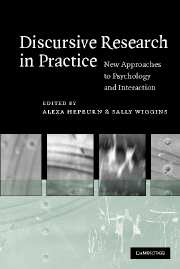Book contents
- Frontmatter
- Contents
- List of figures
- List of contributors
- Acknowledgements
- 1 Discursive research: themes and debates
- Part I Psychology in action
- Part II Professionals and clients
- Part III Youth and institutions
- 11 ‘Doing reluctance’: managing delivery of assessments in peer evaluation
- 12 A valid person: non-competence as a conversational outcome
- 13 Discursive practices in talking problems during a school–family meeting
- 14 Food abuse: mealtimes, helplines and ‘troubled’ eating
- 15 Discursive research: applications and implications
- Appendix: transcription notation
- References
- Index
14 - Food abuse: mealtimes, helplines and ‘troubled’ eating
Published online by Cambridge University Press: 04 November 2009
- Frontmatter
- Contents
- List of figures
- List of contributors
- Acknowledgements
- 1 Discursive research: themes and debates
- Part I Psychology in action
- Part II Professionals and clients
- Part III Youth and institutions
- 11 ‘Doing reluctance’: managing delivery of assessments in peer evaluation
- 12 A valid person: non-competence as a conversational outcome
- 13 Discursive practices in talking problems during a school–family meeting
- 14 Food abuse: mealtimes, helplines and ‘troubled’ eating
- 15 Discursive research: applications and implications
- Appendix: transcription notation
- References
- Index
Summary
Introduction
Feeding children can be one of the most challenging and frustrating aspects of raising a family. This is often exacerbated by conflicting guidelines over what the ‘correct’ amount of food and ‘proper’ eating actually entails. The issue becomes muddier still when parents are accused of mistreating their children by not feeding them properly, or when eating becomes troubled in some way. Yet how are parents to ‘know’ how much food is enough and when their child is ‘full’? How is food negotiated on a daily level? In this chapter, we show how discursive psychology can provide a way of understanding these issues that goes beyond guidelines and measurements. It enables us to examine the practices within which food is negotiated and used to hold others accountable. Like the other chapters in this section of the book, eating practices can also be situations in which an asymmetry of competence is produced; where one party is treated as being a less-than-valid person (in the case of family practices, this is often the child). As we shall see later, the asymmetry can also be reversed, where one person (adult or child) can claim to have greater ‘access’ to concepts such as ‘appetite’ and ‘hunger’. Not only does this help us to understand the complexity of eating practices; it also highlights features of the parent/child relationship and the institutionality of families.
- Type
- Chapter
- Information
- Discursive Research in PracticeNew Approaches to Psychology and Interaction, pp. 263 - 280Publisher: Cambridge University PressPrint publication year: 2007
- 5
- Cited by



